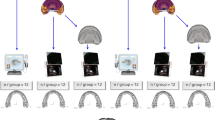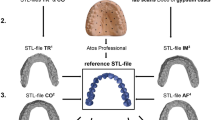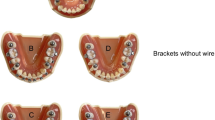Abstract
Objectives
Introducing a new approach to evaluate the accuracy of digital impression methods for full-arch scans, avoiding “best-fit alignment.”
Materials and methods
A lower jaw model with a straight metal bar between the second molars of both quadrants was directly digitized using an intraoral scanner (True Definition, TRD, n = 12) and indirectly digitized (D810, CON, n = 12) after impression and plaster cast. A dataset of the bar from a coordinate measuring machine served as reference (REF). Datasets obtained from test groups were analyzed using inspection software to determine the aberration of the bar length, the linear shift (in X-, Y-, Z-axis) and the angle deviation (α overall, α coronal, α horizontal) caused by the digitalization method. Mann–Whitney U and unpaired two-sample Student’s t test were implemented to detect differences. The level of significance was set at 5 %.
Results
Concerning the bar length, no significant differences were found between groups. In view of the linear shift, CON showed significantly higher values than TRD in Y-axis (p = 0.003) and in Z-axis (p = 0.040). Regarding the angle measurement, TRD showed significant smaller values than CON for α overall (p = 0.006) and for α coronal (p = 0.005).
Conclusions
This in vitro study shows that intraoral scanning systems seem to show the same or even higher accuracy than the conventional impression with subsequent indirect digitalization.
Clinical relevance
Intraoral scanners have proven excellent accuracy for single teeth or small spans. However, insufficient data is available about their accuracy for full-arch scans. The presented new approach seems to be suitable to precisely analyze differences in the accuracy of different digitalization methods without using best-fit alignment.




Similar content being viewed by others
References
Beuer F, Schweiger J, Edelhoff D (2008) Digital dentistry: an overview of recent developments for CAD/CAM generated restorations. Br Dent J 204:505–511
Miyazaki T, Hotta Y, Kunii J, Kuriyama S, Tamaki Y (2009) A review of dental CAD/CAM: current status and future perspectives from 20 years of experience. Dent Mater J 28:44–56
Bosch G, Ender A, Mehl A (2014) A 3-dimensional accuracy analysis of chairside CAD/CAM milling processes. J Prosthet Dent 112:1425–31
Ender A, Mehl A (2013) Accuracy of complete-arch dental impressions: a new method of measuring trueness and precision. J Prosthet Dent 109:121–128
Quaas S, Rudolph H, Luthardt RG (2007) Direct mechanical data acquisition of dental impressions for the manufacturing of CAD/CAM restorations. J Dent 35:903–908
Guth JF, Keul C, Stimmelmayr M, Beuer F, Edelhoff D (2013) Accuracy of digital models obtained by direct and indirect data capturing. Clin Oral Investig 17:1201–1208
Keul C, Stawarczyk B, Erdelt KJ, Beuer F, Edelhoff D, Guth JF (2014) Fit of 4-unit FDPs made of zirconia and CoCr-alloy after chairside and labside digitalization—a laboratory study. Dent Mater 30:400–407
Christensen GJ (2008) The challenge to conventional impressions. J Am Dent Assoc 139:347–349
Christensen GJ (2008) Will digital impressions eliminate the current problems with conventional impressions? J Am Dent Assoc 139:761–763
Chandran DT, Jagger DC, Jagger RG, Barbour ME (2010) Two- and three-dimensional accuracy of dental impression materials: effects of storage time and moisture contamination. Biomed Mater Eng 20:243–249
Al-Bakri IA, Hussey D, Al-Omari WM (2007) The dimensional accuracy of four impression techniques with the use of addition silicone impression materials. J Clin Dent 18:29–33
Mehl A, Ender A, Mormann W, Attin T (2009) Accuracy testing of a new intraoral 3D camera. Int J Comput Dent 12:11–28
Boeddinghaus M, Breloer ES, Rehmann P, Wostmann B (2015) Accuracy of single-tooth restorations based on intraoral digital and conventional impressions in patients. Clin Oral Investig. doi:10.1007/s00784-015-1430-7
Ender A, Mehl A (2011) Full arch scans: conventional versus digital impressions—an in-vitro study. Int J Comput Dent 14:11–21
Patzelt SB, Emmanouilidi A, Stampf S, Strub JR, Att W (2014) Accuracy of full-arch scans using intraoral scanners. Clin Oral Investig 18:1687–1694
Flugge TV, Schlager S, Nelson K, Nahles S, Metzger MC (2013) Precision of intraoral digital dental impressions with iTero and extraoral digitization with the iTero and a model scanner. Am J Orthod Dentofac Orthop 144:471–478
Ender A, Mehl A (2013) Influence of scanning strategies on the accuracy of digital intraoral scanning systems. Int J Comput Dent 16:11–21
Grünheid T, McCarthy SD, Larson BE (2014) Clinical use of a direct chairside oral scanner: an assessment of accuracy, time, and patient acceptance. Am J Orthod Dentofac Orthop 146:673–82
Giménez B, Özcan M, Martínez-Rus F, Pradíes G (2015) Accuracy of a digital impression system based on active triangulation technology with blue light for implants: effect of clinically relevant parameters. Implant Dent 24:498–504
Giménez B, Pradíes G, Martínez-Rus F, Özcan M (2015) Accuracy of two digital implant impression systems based on confocal microscopy with variations in customized software and clinical parameters. Int J Oral Maxillofac Implants 30:56–64
Ender A, Mehl A (2015) In-vitro evaluation of the accuracy of conventional and digital methods of obtaining full-arch dental impressions. Quintessence Int 46:9–17
23 Accuracy (trueness and precision) of measurement methods and results—part 1: general principles and definitions (ISO 5725–1:1994)
van der Meer WJ, Andriessen FS, Wismeijer D, Ren Y (2012) Application of intra-oral dental scanners in the digital workflow of implantology. PLoS One 7, e43312
Seelbach P, Brueckel C, Wostmann B (2013) Accuracy of digital and conventional impression techniques and workflow. Clin Oral Investig 17:1759–1764
Balkenhol M, Haunschild S, Erbe C, Wöstmann B (2010) Influence of prolonged setting time on permanent deformation of elastomeric impression materials. J Prosthet Dent 103:288–294
Sahin S, Cehreli MC (2001) The significance of passive framework fit in implant prosthodontics: current status. Implant Dent 10:85–92
Giménez B, Özcan M, Martínez-Rus F, Pradíes G (2015) Accuracy of a digital impression system based on active wavefront sampling technology for implants considering operator experience, implant angulation, and depth. Clin Implant Dent Relat Res 17(1):e54–64
Acknowledgments
The authors thank 3M ESPE, Seefeld, Germany, for the support of the study and Createch medical, Mendaro, Spain, for conducting the CMM measurements.
Author information
Authors and Affiliations
Corresponding author
Ethics declarations
The present study does not contain clinical patient data.
Conflict of interest
The study was supported by a research grant from 3M Espe Company (Seefeld, Germany). The first and second authors declare that they receive personal fees from 3M ESPE, Seefeld, Germany, outside the submitted work for scientific lectures.
Rights and permissions
About this article
Cite this article
Güth, JF., Edelhoff, D., Schweiger, J. et al. A new method for the evaluation of the accuracy of full-arch digital impressions in vitro. Clin Oral Invest 20, 1487–1494 (2016). https://doi.org/10.1007/s00784-015-1626-x
Received:
Accepted:
Published:
Issue Date:
DOI: https://doi.org/10.1007/s00784-015-1626-x




